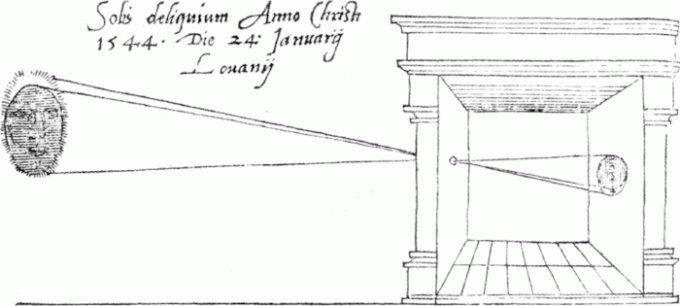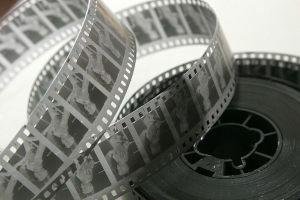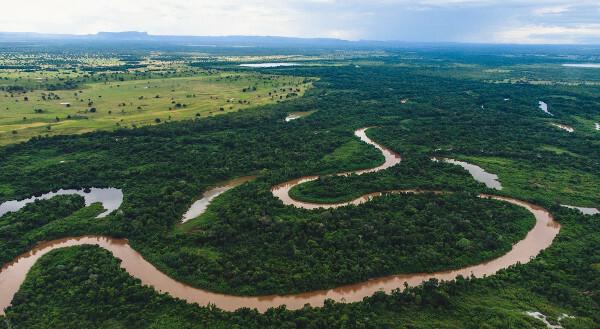A history of photography began in the 19th century, but the development of the camera was only possible later on through studies carried out on hole-punch cameras. Joseph Niépce developed a metal plate coated with bitumen and used it in conjunction with a camera obscura to produce the first photograph. Following Niépce's invention, the daguerreotype was the first “photographing machine” to become popular.
The first photograph taken on Brazilian soil was a daguerreotype in 1840. Dom Pedro II bought the first device of its kind in the same year, which is considered the first in Brazil.
Kodak, an American company founded at the end of the 19th century, was responsible for major innovations in photographing machines and their accessories and helped to popularize photography. The first commercially available digital camera was created by this company in 1975. The first cell phone with a digital camera was launched in the market in 1999.
Read too: History of television — from invention to popularization of the device in Brazil and in the world
Topics of this article
- 1 - Summary about the history of photography
-
2 - How did photography come about?
- → Image registration with pinhole darkroom
- → The first photograph and the invention of the daguerreotype
- 3 - Evolution of photography
- 4 - History of photography in Brazil
- 5 - What is the importance of photography?
- 6 - Curiosities about photography
Summary about the history of photography
- The history of photography began with Joseph Nicéphore Niépce. He recorded the view from his window in 1826. This is considered the oldest photograph.
- Hours were needed to produce a photograph when the first photographic machines were created.
- The daguerreotype reduced the production time of a photograph to about 30 seconds, allowing people to be photographed.
- Several inventions changed the way of photographing, such as the photographic roll, the negative, the colored film and the digital camera.
- Currently, more than 10 billion photographs are taken per day, millions of them are posted daily on social networks.
How did photography come about?
The history of photography began two centuries ago, but for some historians it may be even older. The word photography is formed by two other words: photo, which means "light"”; and grafia, which means something like “writing” or “recording”. Therefore, photography literally means “writing with light”.
Do not stop now... There's more after the publicity ;)
→ Image registration with pinhole darkroom
Photography was only possible because of a natural phenomenon in which light, which travels in a straight line, when passing through a hole in the wall of a darkroom, projects the image from the outside onto the inside wall opposite the hole, with the image projected upside down.
Sometimes this phenomenon occurs naturally in caves, which could have led humans to develop cave paintings. In antiquity, it was studied by Greeks and Chinese., and, in the Middle Ages, it was the Arabs who stood out in its study.
In the Renaissance, several scholars dedicated themselves to studying camera obscuras with holes. the italian leonardo da vinci produced more than 200 experiments with darkrooms and he was the first to explain the workings of the eye, comparing it to the camera obscura.
The earliest record of how a camera obscura with a hole worked was produced by Gemma Frisius, in which he observed the phenomenon of the solar eclipse of January 24, 1544. Yet in the renaissance period, glass lenses were used for the first time in darkrooms, which greatly improved the resolution of the projected image.
Some specialists in 17th century art claim that the painter Johannes Vermeerknown for the work Girl with the pearl earring, used a camera obscura to produce some of his works. Perhaps this was the first time that someone "wrote with light".

→ The first photograph and the invention of the daguerreotype
it was the french Joseph Nicephore Niepce who developed the first camera obscura that managed to record what was projected into it, that is, he he developed the first mechanism that took a photograph.
Niépce's great invention was a rectangular plate made of tin and covered with a layer of bitumen, fixed at the bottom of a camera obscura. Sunlight entered the chamber and burned the bitumen on the plate, creating the photograph. To produce the first photograph, Niépce left the plate exposed to light for eight hours.

Louis Jacques Mande Daguerremade a deal with Niépce and received the right to use his invention, perfecting it and creating the daguerreotype, which took about 30 seconds to take a picture. It was the first large-scale photo-taking device.
The daguerreotype patent was sold to the French State, which placed it in the public domain. Since then, cameras have gone through great development. in several countries.
See too: Glasses, magnifying glass, camera and other optical instruments
evolution of photography
1839 |
The daguerreotype begins to be commercialized. He was very popular during most of the 19th century. It allowed adjusting the focus of the image by moving the lens back and forth. |
 |
1851 |
Frederick Scott Archer developed the wet collodion process, which allowed many images to be printed from a negative. Photographs of famous people, places and wars began to be sold in large numbers. |
 |
1889 |
Kodak, George Eastman's company, created the first roll of film. Before, after taking the photograph, the photographer had to submit the plate that captured the image through a time-consuming process, which required several steps and chemical products. With the roll of film, several photos were taken in sequence and developed later. |
 |
1912 |
Kodak started selling cameras called Vest Pocket, or “vest pocket” camera, the first camera that fit in a pocket. Millions of Vest Pockets have been sold. They were used a lot by soldiers in World War I. |
 |
1936 |
Kodak once again revolutionized the world of photography by launching the Kodachrome, the first widely marketed camera to use color film. |
 |
1972 |
The first digital cameras were developed. In 1975, Kodak released the Cromemco Cyclops, the first mass-marketed digital camera. |
|
1999 |
The Kyocera VP-210 was launched in Japan, the first cell phone with a camera in history. The images were 0.1 megapixels and the cell phone had the capacity to store 20 photos. |
 |
History of photography in Brazil
In 1840, the French abbot Louis Comte took the first photograph in Brazil. The abbot and the daguerreotype used arrived in Rio de Janeiro on the French ship L'Oriental-Hydrographe, a kind of school ship that at the time was making a scientific expedition around the globe. He was supposed to make a two-and-a-half-year voyage, but the ship ended up sinking off the Chilean coast, six months after the first photograph taken of Brazil.
The entire 80-member crew survived the sinking, as did part of the ship's cargo, including the first photograph taken in Brazil. A day after the first photograph, the Jornal do Comércio reported the feat of Louis Comte, stating that the image was ready in “just nine minutes”.
Days later, Louis Comte presented the daguerreotype to Dom Pedro II. The Emperor of Brazil acquired a daguerreotype in March 1840, just three months after the first photograph taken in Brazil. Dom Pedro II was passionate about the new technologies of the period, like the telegraph, the phone, the lamp and the photograph.
During his lifetime he took hundreds of pictures and bought thousands more. His collection of photographs was donated in will to the National Library and was renamed the Thereza Christina Maria Collection. The collection has more than 20,000 photographs.
From the 1850s, photographers opened studios in the main capitals of the country, producing mainly portraits. In the 1860s, some photographers began to photograph the daily life of Brazilian streets and to photograph urban and rural landscapes, and some of them were sponsored by Dom Pedro II.
Marc Ferrez was one of the most popular Brazilian photographers of the 19th century. From 1875, he participated in scientific expeditions through the interior of Brazil, photographing states such as Bahia, Mato Grosso and Goiás. Ferrez also photographed various economic activities practiced in Brazil and various state works, such as the construction of roads, railways and ports.
At the beginning of the twentieth century, there werethe first traveling photographers from Brazil, popularly known as “lambe-lambe” photographers. Their presence with their large tripod cameras was common in the big cities of Brazil until the 1970s. Even today there are some lambe-lambe active in our country..
Two theories try to explain the origin of the nickname lambe-lambe. One of them claims that photographers licked the glass plates to find out which side should be used to produce the photograph; the other defends that they licked the envelope in which the photograph was delivered to the client.
How important is photography?
The first great importance of photography is the preservation of memory. Photography allowed human beings to perpetuate memories of places, people and historical events. It connects us directly to our past, our ancestors, our country and our humanity.
The photograph too It is an effective means of reporting, having great power to influence public opinion and even to change the course of history. In 1904, missionary Alice Harris photographed Nsala de Wala, who was observing the hands and one foot of his five-year-old daughter, who were cut by the Belgians (who dominated the Congo), because he had not reached the established quota for the production of rubber.

The image was spread across the planet and was important for people to understand and protest against the horrors that occurred in the so-called Belgian Congo. In 1908, Congo ceased to be the personal property of Belgian King Leopold II.
the photograph also it is an artistic expression, through which photographers express their feelings, opinions and, often, make criticisms. Like any artistic manifestation, photography can give us a feeling of well-being, discomfort, pleasure, joy and sadness. It often makes us reflect and can serve as a source of inspiration.
The photograph too It is widely used in different areas of knowledge. and in various professions, such as anthropology, history, journalism, medicine, geography, astronomy, among others.
Know more: Myths and truths about man's trip to the moon
Facts about photography
→ Most viewed photograph in the world
The most viewed photograph in the world éWindows XP splash screen image, called Bliss. It was taken by Charles O'Rear, a former National Geographic photographer, in 1996.
→ Most liked photo in history
The most liked photo in history is that of the player Leonel Messi lifting the 2022 World Cup trophy. It was posted by him on Instagram and reached over 70 million likes. Before her, the photograph with the most likes it was a photo of an egg, with over 50 million likes.
→ First photographs of nudes of history
É attributed to photographer Jacques Felix Antoine Moulin the production of the first nudes of history. In the late 1840s, he began to photograph nude and semi-nude women, mainly prostitutes and dancers in Paris. At the time, taking this kind of photograph it was considered a crime. He was arrested in 1851, and convicted of obscenity, spending a month in jail.
→ First record of people in a photograph
In 1828, Louis Daguerre accidentally captured the first people in a photograph. He photographed a boulevard in Paris and recorded a shoeshine boy and a man. The people walking along the sidewalk were not photographed, as it took time for the light to produce the photo, but the men photographed moved little during the image.
→ Photos with Apple devices
In 2022, Apple disclosed that about three trillion of photographs were taken by the company's devices in the previous year. That's approximately eight billion photos per day, i.e. one photo per inhabitant of planet earth. It is worth remembering that this data relates only to photos taken with Apple devices.
→ Photographs taken on the Moon
The iconic first photographs taken on the Moon were taken by cameras developed by the US company Hasselblad. The cameras were adaptedto withstand low gravity, huge shakes on the rocket launch and the extreme temperatures faced on the trip to the Moon.
On the Apollo 11 Mission, two cameras were used, and, after removing the film rolls from them, the astronauts left them on the Moon to reduce the weight of the Eagle module, which carried extra weight because of the rocks and soil samples collected. In every Apollo Project, a total of 14 cameras were left on our natural satellite.
→ Criticisms against the invention of photography
The invention of photography did not make everyone happy. Several demonstrations took place against the new invention in France. Among the main critics were religious groups who were opposed to capturing images of things made by God and painters, mainly portraitists, who feared that the new technology would end the profession.
image credits
[1] Auckland Museum / Wikimedia Commons
[2] Wikimedia Commons
[3] Berthold Werner/Wikimedia Commons
[4] Wikimedia Commons
[5] Wikimedia Commons
[6] Wikimedia Commons
Sources
AMAR, Pierre-Jean. history of photography. Editions 70, Lisbon, 2017.
KOSSOY, Boris. Photography and history. Editorial Studio, São Paulo, 2014.
SONTANG, Susan. FIGUEIREDO, Rubens. about photography. Companhia das Letras, São Paulo, 2004.
How to build a pinhole camera obscura.
See here what an orifice darkroom is and also see what its daily use is.
Access the text to learn more about the history of television. Understand how it came about, how it was popularized and how it arrived in Brazil.
Do you know what optical instruments are and what they are for? Optical instruments use flat and spherical lenses and mirrors to produce sharper, corrected, or enlarged images of objects near or far away. Check out some of the most important optical instruments, such as eyeglasses, magnifying glasses and spotting scopes.
Is what you really know about the Apollo 11 mission true? Check out some myths and truths about the arrival of man on the moon.
Learn about the operating principle of the process of recording images on photographic films.



